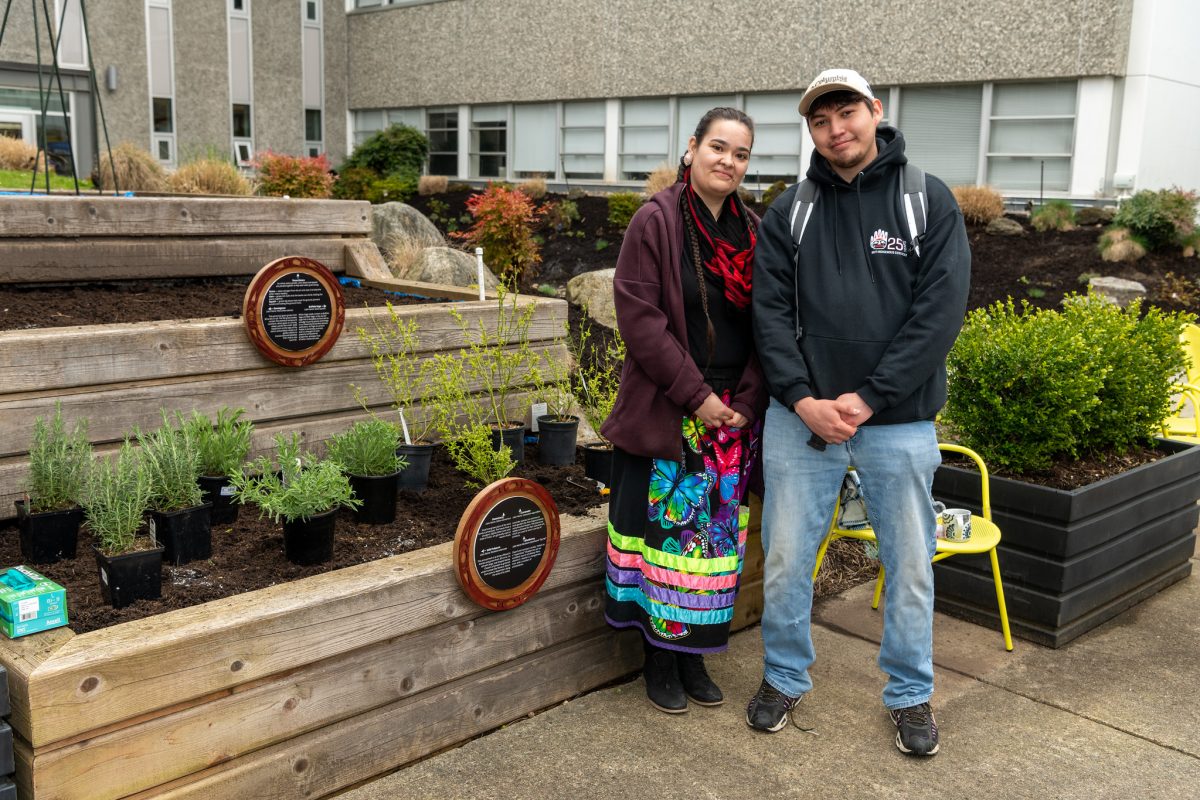
BCIT officially opened its Indigenous Garden earlier this month. The tiered garden in the courtyard, between SW1 and SW3 on the Burnaby Campus, provides a dedicated area to cultivate a range of Indigenous plants and is also built to be a peaceful green space for students and staff to enjoy.
The range of plants includes Sweetgrass, Buffalo Sage, Blueberry, and Wild Tobacco.
The development of the garden was a collaboration between a range of campus partners, including Indigenous Initiatives and Partnerships, Facilities and Campus Development, School of Construction and the Environment, Student Life, Applied Research, Student Financial Aid and Awards, International, BCIT Student Association, who are part of the BCIT Food Security Working Group – a multi-stakeholder platform committed to engaging in the promotion of food security resources on-and-off the BCIT campus. The BCIT Food Security Working Group provides a centralized support, such as the tiers, for improved communication, collaboration and community building across campus. The working group advances initiatives related to food security and works towards a campus culture where student food insecurity is destigmatized.
BCIT Indigenous Initiatives and Partnerships creates a sense of inclusion and belonging for Indigenous students through cultural and educational activities. Students and staff across BCIT are invited to participate in ceremonies celebrating the diversity and richness of the Indigenous culture. The Indigenous Gathering Place is located in SW1 room 1521.
The new garden is one of several spaces across campus that are planted with edible plants for staff and students.
The edible plants at the new garden, the squash, corn, and bean, reflect Indigenous traditions. These are some of the most important crops amongst Indigenous peoples in Canada. They are known as the Three Sisters because they are often planted together in a technique known as companion planting.
A traditional Three Sisters’ soup using these ingredients was served at the opening of the garden.
“The garden tiers are already being used for the gathering of staff and students, for smudging, and we look forward to seeing the Three Sisters grow and be able to access our sacred medicines (cedar/tiers built with, tobacco, sage and sweetgrass),” shares Zaa Joseph, Advisor, Indigenous Initiatives and Partnerships. “In my Dakelh language, “Hanayeh” means – where we grow things/plants/vegetables. “Yun whunh ni” – the things we grow have a life and a right to their life and to enjoy it…for which we give thanks when we take it and use it for food. As we move through the pandemic, BCIT students and staff need all the grounding spaces possible, and we are happy to share these tiers with the BCIT community.”
“We wanted to develop this space for the use of the BCIT community. It has been a very fulfilling to work with our campus partners on something that isn’t just a place to enjoy, but that also speaks to the campus’ place on the unceded traditional territories of the Coast Salish Nations,” explains Adam Dickinson, Manager, Transportation and Grounds, BCIT. “As the plants grow in over the next few months, we hope that our campus community will get to appreciate the new green space in the centre of campus.”
SEE MORE: BCIT Indigenous Student Champions: Supporting peers on their educational journey
Three Sisters

In a Three Sisters garden, corn, beans, and squash are planted together to help each other grow strong.
Beans — takes nitrogen from the air and uses it to keep the other sisters healthy.
Corn — grows tall stalks that the beans can climb, holding the plants together.
Squash — grows big leaves that cover the ground, prevent weeds and making the ground moist.
Sweetgrass
Latin Name: Hierochloe odorata
This perennial grass grows from 30 to 60 cm tall. The flat grass blades contain the chemical compound coumarin, which gives it a strong, sweet, vanilla-like smell. Seed heads form at the tops of the stems and produce clusters of golden yellow to bronze-coloured spikelets from mid to late summer.
Buffalo Sage
Latin Name: Salvia apiana
White Sage seeds, known as Buffalo Sage and Bee Sage, is the sacred sage that is bundled and burned as smudge to purify places and things. It is a flowering shrub that attracts pollinators. Its high oil content makes it extremely aromatic, and it is thought to have powerful antibacterial properties, among a host of other medicinal uses.
Wild Tobacco
Latin Name: Nicotiana attenuata
This annual herb is at times offered in thanks and grows from 30 cm to 1m tall with large, oval shaped leaves. Clusters of pinkish to greenish white trumpet-like flowers, bloom from June to September along the ends of its stalks.
Rosemary
Latin Name: Salvia rosmarinus
Small evergreen plant of the mint family (Lamiaceae). The leaves have a pungent, slightly bitter taste and, dried or fresh, are generally used to season foods
Lavender
Latin Name: Lavandula angustifolia
Lavender species are common in herb gardens for their fragrant leaves and attractive flowers. The plants are widely cultivated for their essential oils, which are used to scent a variety of products.
Have you subscribed? Sign-up to receive the latest news on BCIT.

